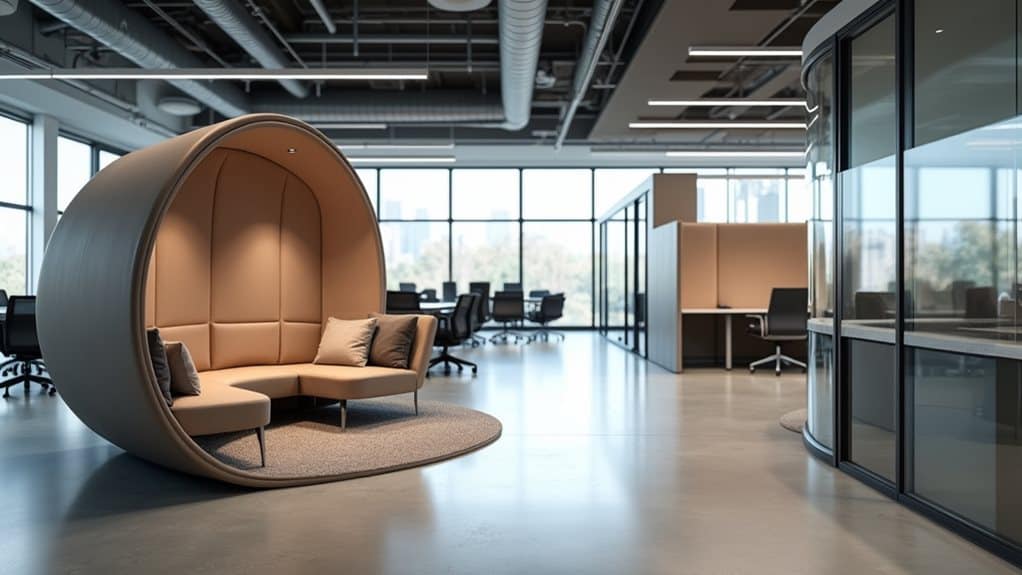To make hybrid work models successful, you’ll need to establish clear boundaries between remote and in-office days while gathering employee feedback to create realistic policies. Focus on outcome-based performance metrics rather than physical presence, guarantee equal access to resources for all team members, and implement standardized communication protocols that don’t favor either location. Develop specialized leadership training for managing distributed teams, create digital-first documentation systems, and establish continuous feedback loops to adapt your strategy. The following thorough approach will transform your workplace dynamics.
Defining Your Organization’s Hybrid Work Strategy

How can organizations successfully steer through the complex shift to hybrid work without falling into common pitfalls that derail productivity and employee satisfaction?
You’ll need to establish clear boundaries between in-office and remote work days while considering your team’s unique needs. Start by gathering thorough employee feedback through surveys and focus groups to understand preferences, challenges, and productivity patterns. This data becomes your foundation for creating realistic policies that work for everyone.
Don’t overlook remote onboarding processes, as they’re vital for maintaining company culture and guaranteeing new hires feel connected. Define specific collaboration requirements, meeting protocols, and communication expectations.
Set measurable goals for both remote and in-person work to track success. Additionally, consider leveraging project & task management tools to facilitate efficient workflow and communication among team members. Remember, your hybrid strategy isn’t set in stone—it should evolve based on ongoing feedback and changing business needs.
Establishing Clear Communication Protocols for Remote and In-Office Teams
Because communication breakdowns represent the fastest route to hybrid work failure, you must establish protocols that bridge the gap between remote and in-office team members seamlessly.
Start by implementing standardized meeting formats that guarantee equal participation regardless of location. Create shared digital spaces where all team members can access real-time updates, project status, and company announcements simultaneously.
Develop remote engagement strategies that include scheduled check-ins, virtual coffee breaks, and collaborative problem-solving sessions. These touchpoints maintain connection beyond formal meetings.
Don’t overlook team bonding activities—organize virtual game nights, online lunch sessions, or hybrid social hours that unite distributed colleagues.
Set clear expectations for response times across different communication channels. Establish when to use email versus instant messaging, and define urgency levels for various requests to prevent miscommunication.
Redesigning Physical Office Spaces for Flexible Collaboration

You’ll need to transform your office layout into a dynamic environment that adapts to different work styles and team sizes throughout the day.
Start by investing in modular furniture that can be quickly reconfigured for spontaneous meetings, focused work sessions, or larger collaborative projects.
Don’t forget to create dedicated technology integration zones and implement smart booking systems that allow employees to reserve spaces based on their specific needs and the tools they’ll require.
Modular Furniture Solutions
Flexibility has become the cornerstone of modern workplace design, and modular furniture solutions offer the perfect answer to today’s dynamic office needs.
You’ll find that these adaptable systems transform your workspace instantly, accommodating different team sizes and project requirements without major renovations. Modular desks, chairs, and storage units can be reconfigured within minutes, supporting both individual focus work and collaborative workspaces seamlessly.
When selecting modular pieces, prioritize ergonomic furniture that maintains comfort across various configurations. Look for systems with standardized connections, allowing components to integrate effortlessly.
Rolling elements add mobility, while stackable options maximize storage efficiency. You’ll appreciate how these solutions reduce long-term costs by eliminating the need for complete furniture overhauls when your team’s needs evolve, making them crucial investments for successful hybrid work environments.
Technology Integration Zones
Three distinct technology zones can transform your office into a collaboration powerhouse that adapts to any work style or meeting format.
You’ll want to establish a high-tech presentation area equipped with interactive displays, wireless screen sharing, and premium audio systems for client meetings and team presentations.
Next, create a casual tech lounge featuring tablets, charging stations, and comfortable seating where employees can quickly connect and brainstorm.
Finally, design dedicated video conferencing pods with professional lighting, noise cancellation, and multiple camera angles to guarantee seamless communication with remote team members.
These remote collaboration tools integrated into your flexible workspace design eliminate the friction between in-person and virtual interactions, making every meeting productive regardless of participants’ locations.
Booking Systems Implementation
Smart technology zones mean nothing without an efficient system to manage them.
You’ll need a robust booking platform that seamlessly integrates with your existing infrastructure while prioritizing user experience above all else.
The best booking system features include real-time availability updates, calendar synchronization, and mobile accessibility that lets employees reserve spaces from anywhere.
Focus on intuitive design that requires minimal training.
Your team shouldn’t struggle with complex interfaces when they’re simply trying to book a conference room.
Include features like automated check-ins, usage analytics, and cancellation policies that prevent no-shows from wasting valuable space.
Implementing Technology Solutions That Support Seamless Transitions

When employees toggle between home offices and corporate headquarters, they need technology that adapts as quickly as they do. Your success depends on selecting platforms that maintain consistency across locations.
Cloud collaboration tools should sync documents, projects, and communications instantly, guaranteeing you’re never working with outdated information. Microsoft Teams, Slack, and Google Workspace excel at this seamless integration.
Don’t overlook the human element during changes. Virtual team building activities help maintain connections when staff splits between locations.
Schedule regular video check-ins, online coffee breaks, and collaborative brainstorming sessions. These touchpoints preserve team culture regardless of physical distance.
Mobile-first solutions prove crucial for hybrid environments. You’ll need apps that function identically on laptops, tablets, and smartphones.
This consistency eliminates the frustration of switching between different interfaces throughout your workday.
Maintaining Company Culture Across Distributed Teams
Building a cohesive company culture becomes markedly more challenging once your workforce spreads across multiple locations and time zones.
You’ll need intentional strategies to maintain the shared values, behaviors, and connections that define your organization’s identity.
Employee engagement requires consistent effort across all team members, regardless of their physical location.
You can’t rely on spontaneous hallway conversations or casual coffee chats to build relationships anymore.
Instead, you must create structured opportunities for meaningful interactions.
Consider implementing these crucial practices:
- Schedule regular virtual team building activities that encourage personal connections beyond work tasks
- Establish clear communication protocols that guarantee everyone feels heard and valued
- Create digital spaces where employees can share achievements, celebrate milestones, and maintain social bonds
Success depends on your commitment to fostering genuine relationships through deliberate, technology-enabled touchpoints. By leveraging profile features, you can enhance team collaboration and ensure everyone stays aligned with the company culture.
Ensuring Equity Between Remote and In-Person Employees

You’ll face a critical challenge in hybrid work environments: guaranteeing your remote employees don’t become second-class citizens while maintaining fairness for your in-office team members.
This equity issue requires deliberate attention to three key areas that can make or break your hybrid model’s success. You must establish equal access to resources, implement fair performance evaluation standards, and create inclusive meeting participation practices that give every employee—regardless of location—the same opportunities to contribute and advance.
Equal Access to Resources
One of the most critical challenges in hybrid work environments stems from the invisible divide that can emerge between remote and in-office employees regarding access to resources, opportunities, and information.
You’ll need to actively bridge this gap to maintain team cohesion and productivity.
Effective resource sharing requires intentional planning and systematic implementation.
Consider these vital strategies:
- Digital-first documentation – Store all important files, meeting notes, and project updates in cloud-based platforms accessible to everyone
- Technology equity – Provide remote workers with the same quality equipment, software licenses, and technical support as in-office staff
- Communication standardization – Use consistent channels and protocols that don’t favor physical presence over virtual participation
Equitable access isn’t just about tools—it’s about creating an environment where location doesn’t determine your team members’ success potential.
Fair Performance Evaluation Standards
When performance evaluations become inadvertently biased toward visible, in-office behaviors, remote employees face an uphill battle that undermines the entire hybrid model’s effectiveness.
You’ll need to establish clear performance metrics that focus on outcomes rather than physical presence. Traditional evaluation methods often favor employees who participate in hallway conversations or stay late at the office, creating unfair advantages for in-person workers.
Implement structured feedback loops that capture contributions from all team members, regardless of location.
You should measure results like project completion rates, quality standards, and client satisfaction scores. Regular one-on-one meetings guarantee remote employees receive equal recognition for their achievements.
Inclusive Meeting Participation Practices
Building on fair evaluation practices, meeting dynamics present another substantial challenge where remote employees often find themselves at a disadvantage.
You’ll notice in-person attendees naturally dominate conversations, while remote participants struggle with audio delays, technical issues, and reduced visibility. This imbalance undermines team cohesion and limits diverse perspectives.
To foster remote engagement, implement these crucial strategies:
- Rotate meeting leadership between remote and in-person employees to guarantee balanced facilitation
- Use collaborative digital tools for inclusive brainstorming sessions that give everyone equal input opportunities
- Establish clear speaking protocols with designated time slots and visual cues for remote participants
You must actively monitor participation levels and adjust your approach accordingly.
Consider hybrid-friendly formats like breakout rooms or asynchronous components that accommodate different working styles and time zones effectively.
Managing Performance and Productivity in Hybrid Environments

Although traditional performance metrics often fall short in hybrid environments, measuring productivity effectively requires a fundamental shift from tracking time to evaluating outcomes.
You’ll need to establish clear, measurable goals that focus on deliverables rather than hours worked. Performance metrics should emphasize quality, project completion rates, and collaborative contributions across your team.
Modern productivity tools become crucial for maintaining visibility without micromanaging. Consider implementing project management platforms that track progress transparently while allowing flexibility in how work gets accomplished.
Regular check-ins should concentrate on obstacle removal and support rather than surveillance.
You’ll discover that trust-based management yields better results than rigid monitoring. Provide autonomy while maintaining accountability through structured feedback cycles.
This approach respects your team’s diverse working styles while guaranteeing consistent output quality.
Addressing the Challenges of Asynchronous Work
When your team operates across different schedules and locations, asynchronous work becomes both a necessity and a strategic advantage that requires careful orchestration.
You’ll need to master the art of selecting communication tools that support delayed responses while maintaining project momentum, guaranteeing everyone stays connected without being constantly available.
Managing time zones effectively means creating workflows that accommodate diverse schedules, allowing team members to contribute meaningfully regardless of when they’re online.
Communication Tool Selection
Since remote teams can’t rely on spontaneous hallway conversations or quick desk-side chats, you’ll need to be strategic about selecting communication tools that bridge the gaps created by asynchronous work.
The right virtual collaboration tools can transform scattered team interactions into cohesive workflows that maintain productivity across time zones.
Your tool selection should prioritize functionality over features. Consider these critical categories:
- Instant messaging platforms for quick updates and informal communication
- Project management systems that centralize tasks and deadlines
- Video conferencing solutions for face-to-face connection when needed
Effective team engagement strategies require matching tools to specific communication needs.
You shouldn’t overwhelm your team with multiple platforms that serve similar purposes. Instead, choose complementary tools that create seamless workflows, guaranteeing everyone stays connected regardless of their physical location or working hours.
Time Zone Management
How can you maintain team cohesion when your colleagues are starting their workday while you’re winding down for the evening? Time zone coordination becomes your strategic advantage when approached thoughtfully.
You’ll need to identify overlapping hours where most team members can collaborate in real-time, then protect these windows for crucial meetings and decision-making sessions.
Scheduling flexibility transforms potential friction into opportunity. Consider rotating meeting times weekly, guaranteeing no single time zone bears the burden of inconvenient hours consistently.
You should establish clear handoff protocols, where team members document progress and next steps before logging off.
Create shared calendars displaying everyone’s working hours and use asynchronous communication tools for non-urgent matters.
When you respect colleagues’ boundaries while maintaining productivity, distributed teams thrive across any geographical divide.
Training Leaders to Manage Hybrid Teams Effectively

The shift to hybrid work models demands a fundamental change in leadership capabilities, as managing distributed teams requires skills that many leaders haven’t fully developed.
You’ll need to invest in thorough leadership development programs that address the unique challenges of overseeing both remote and in-office employees simultaneously.
Effective hybrid leadership training should focus on:
- Communication mastery – Learning to facilitate meaningful connections across different work environments
- Performance measurement – Developing outcome-based evaluation methods rather than relying on physical presence
- Technology integration – Mastering digital tools that enable seamless collaboration and team coordination
Understanding team dynamics becomes essential when you’re managing people who rarely share the same physical space.
You’ll need to recognize how different personalities thrive in various work settings and adapt your management approach accordingly.
Measuring Success and Iterating on Your Hybrid Model
What metrics truly indicate whether your hybrid work model is delivering on its promises? You’ll need to track both quantitative and qualitative success metrics to get the full picture.
Start with productivity measures, employee retention rates, and collaboration frequency across teams. However, don’t overlook the power of regular employee feedback through surveys and one-on-one conversations.
Your hybrid model isn’t set in stone—it’s a living system that requires constant refinement. When employee feedback reveals pain points or success metrics show declining performance, you must act quickly.
Create feedback loops that allow for rapid iteration, whether that’s adjusting meeting schedules, revising collaboration tools, or modifying office attendance requirements.
Frequently Asked Questions
How Do I Handle Childcare Emergencies While Working From Home?
You should establish emergency planning protocols beforehand. Keep backup childcare resources readily available, like trusted neighbors or family members. Communicate immediately with your manager about the situation, and don’t hesitate to reschedule non-urgent meetings when needed.
What Should I Wear for Video Calls Versus In-Office Days?
You should wear business casual for video calls, focusing on your upper body’s appearance. For in-office days, choose complete professional attire that matches your workplace’s dress code and company culture expectations.
Can I Expense My Home Internet and Electricity Bills?
You can’t typically expense your entire home internet and electricity bills. However, many companies offer partial internet expenses reimbursement for remote work. Check your employer’s policy regarding electricity reimbursement for home office usage.
How Do I Network Effectively When Working Remotely Most Days?
You’ll build virtual networking through intentional online connections. Join professional video meetups, engage actively on LinkedIn, schedule regular coffee chats with colleagues, participate in industry webinars, and create informal check-ins with teammates to maintain meaningful relationships.
What Happens to My Hybrid Arrangement if I Move Cities?
Your hybrid arrangement depends on company policy regarding remote location changes. You’ll need to discuss tax implications, time zones, and legal requirements with HR. Some companies allow it, while others require renegotiation or office proximity.
Final Thoughts
You’ve got the roadmap to build a thriving hybrid workplace, but success depends on your commitment to implementation. Start with one or two key areas that’ll make the biggest impact for your team, then gradually expand your approach. Remember, hybrid work isn’t a destination—it’s an ongoing process that requires constant attention, feedback, and adjustment. Your willingness to adapt and evolve will determine whether your hybrid model truly works.





